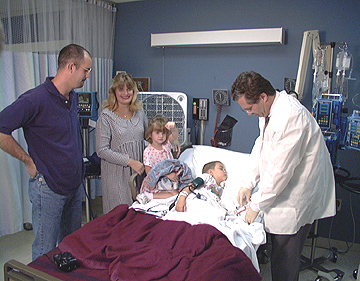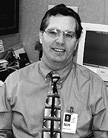
| T H E N I H C A T A L Y S T | J A N U A R Y – F E B R U A R Y 1999 |
|
|
|
MALECH MOVES TO STEM CGDFIRST STEM CELL TRANSPLANTATIONS FOR CGDTAKE ROOT IN NIAID INTRAMURAL PROGRAM |
by Fran Pollner |
 |
|
Harry
Malech delivers allogeneic stem cells to the first CGD patient on the
new protocol. The donor (a younger sister) and parents look on.
|
 |
|
Harry
Malech
|
Harry Malech is cautious but excited. "We’ve achieved substantial engraftment of corrected cells; if the numbers we have today remain stable, we’ll have cured their CGD (chronic granulomatous disease). But we don’t know. It’s very early. The first one, the little boy, is only 70 to 80 days out; the second one, the 24-year-old, is only 40 days out," Harry Malech, deputy chief of the NIAID Laboratory of Host Defenses, said at the end of December.
He spoke of the first two patients with CGD to undergo allogeneic peripheral blood stem cell transplantation under a new protocol that draws upon recent advances in blood stem cell purification and transplantation immunology. A third patient underwent the procedure in mid-January.
Three novel features of this protocol are, first, that the patient receives milder treatments to suppress their own marrow; second, that the stem cells are derived from the donor’s blood by apheresis instead of marrow; and third, most of the lymphocytes are removed from the transplanted donor cells to reduce early graft vs. host disease, with supplemental donor lymphocyte transfusions used later to "stabilize" the graft.
The goal is to correct the neutrophil defect that underlies CGD—and not all the neutrophils have to be in good working order to do that, Malech notes. Correction of only 5 to 10 percent of the body’s neutrophils will result in clinical cure, he says. But numbers are only half the battle—"durability" of the correction is also critical.
CGD was recognized as an entity only in the 1960s and, reflective of the capability of the medical community to treat it then, was given the name "fatal CGD of childhood." Thanks to the work of John Gallin, now Clinical Center director, and others, Malech says, "fatal" fell away as an inevitability, and it became possible for many patients to live into adulthood, with frequency and severity of infection reduced by prophylactic antibiotic and interferon gamma regimens.
"But there’s a sword of Damocles hanging over patients’ heads. They get sudden, overwhelming infections and recurring infections with accumulations of inflammatory cells and scarring that increasingly compromise lung or liver function. Despite improvements, we still have about 1 to 2 percent yearly mortality. Imagine a roomful of 100 children where one or two will die each year. Would you not consider that terrible?"
Malech’s lab focused first on autosomal recessive CGD, which led to the discovery and cloning of the genes underlying the p47phox- and p67phox-deficient types of CGD. By 1992, all four CGD-causing genes had been cloned. "I decided to aim my laboratory program toward the development of gene therapy for CGD," Malech says, thanking NHGRI’s Michael Blaese for his early assistance, "and I viewed this as a very long-term project."
A clinical trial of gene therapy for CGD in 1995–1996 took the patients’ own purified blood stem cells, corrected them with a retrovirus vector outside the body, and returned the cells to the patient. This resulted in several months’ worth of endogenous production of "very tiny numbers" (1 in 2,000 to 10,000) of functionally corrected neutrophils. In the current version of this trial, improved methods of stem cell harvest and purification with more efficient gene transfer have resulted in a fourfold increase in peak numbers of corrected cells in the patients. Although the effect decreases with time, "we still see tiny numbers of corrected cells–at this point beyond eight months," Malech says, observing that "while this is exciting scientifically, we have a way to go with gene transfer." He acknowledges that clinical benefit now is unlikely but emphasizes that this proven durability will be crucial in conjunction with strategies to enhance the engraftment of the incoming gene-corrected cells.
"We are learning things about mild regimens of marrow conditioning from our allogeneic transplant program that we may be able to apply to the gene therapy approach," he notes. Currently, the allogeneic transplant approach applies only to patients with a fully matched sibling donor. The development of gene therapy, then, is still an important goal for the other patients, and the autologous stem cell gene transfer and allogeneic peripheral stem cell transplantation programs proceed apace, "intellectually connected." Both approaches rely, for instance, on novel machinery using antibodies and magnetic beads to extract and purify stem cells. Additional processing in the allogeneic transplant protocol uses an antibody developed by NCI’s Ron Gress to deplete lymphocytes.
A major clinical advance in stem cell biology was the use of recombinant marrow growth factors to cause large numbers of stem cells to come out of the bone marrow and enter the bloodstream, a process called mobilization. This made possible a "revolution" in transplantation, Malech says. "One could use apheresis and special purification methods to separate out large numbers of the desired cells for either autologous or allogeneic transplantation," he says, extending his scientific thanks for their roles in his studies to Susan Leitman and Elizabeth Read, who run the apheresis and special processing units, respectively, in the transfusion medicine department.
As recently as five years ago, he marvels, "the concept of using peripheral blood-mobilized stem cells instead of bone marrow as a source for transplantation was considered revolutionary; now it’s almost become the standard of care."
Recovering stem cells from the blood rather than the marrow is easier on the donor (for allogeneic transplants) or the patient (for autologous transplants) and lends itself to repeat and more exact procedures. "The jury is still out" on whether peripheral blood stem cells are "as fit" as marrow cells to do the job, but it "appears they are," Malech says.
The new allogeneic transplantation protocol was crafted by principal investigator Mitchell Horwitz, a NIAID clinical associate who was formerly with NHLBI and conceived of a collaboration between the CGD team and NHLBI’s John Barrett. "A unique opportunity for our CGD patients occurred because of John Barrett’s novel work in the NHLBI transplant program for cancer patients," Malech relates. "He has been piloting the use of mild conditioning regimens, relying in part on the immune system of the incoming donor cells—the lymphocytes—to act as a wedge to enhance engraftment of donor progenitor cells in recipient marrow."
The investigators hope
to demonstrate in the CGD allogeneic transplant study that it is possible to
achieve a cure with permanent donor cell engraftment while reducing or eliminating
the dangerous and potentially fatal side effects of transplantation. The ability
to ward off graft vs. host disease and to use milder ablative therapy to effect
a transplant that results in a "stable coexistence of both donor and recipient
cells, hopefully for a lifetime," Malech says, could also apply to the
treatment of many other inherited diseases of blood cells. ![]()